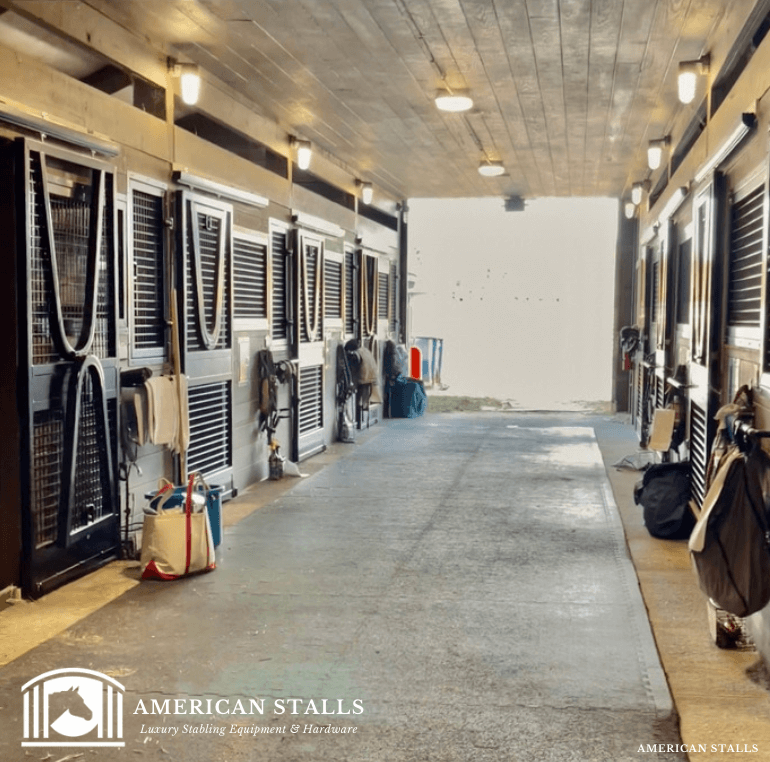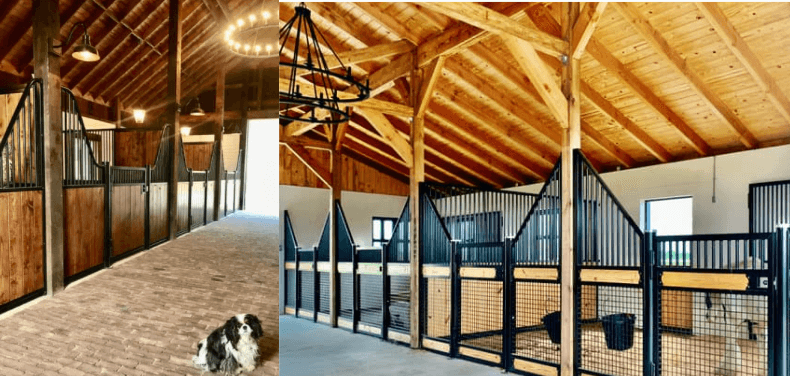In today’s market, there are various types of barn designs, building materials, and barn types. That being said, there are 3 to 4 basic structures that are most popular for horses. In this post, we'd like to cover the different types of popular horse barns and things you should consider during the process.
The first type of barn – and most common – is the post and beam barn. This barn is also referred to as a pole barn, framed barn, and panelized “pre-fabricated” barn. Secondly, we will discuss clear span barn structures. Thirdly, we will discuss the increasingly popular block barns found in hotter climates. Lastly, we will discuss other options such as stabling inside indoor arenas.
Looking for Barn Design that will save you time? We wrote about it extensively in our previous blog posts.
Post & Beam Barns
It is likely that you have been through hundreds of horse barns. If so, it is likely that you’ve walked in many post and beam barns. The post and beam barn (also known as a “pole barn”) is especially popular along the east coast.
This particular style is very popular because it can be put up in a cost-effective manner. There are also times when a general contractor who puts up the shell and the remaining work is left to the builder.

Additionally, the pole barn has cost advantages because it is usually pre-engineered for most land sites or not engineered at all. These barns are usually made with 6’x6’ or 4’x4’ timbers on 12’ or 14’ centers. It is then covered using a single wall construction of tongue and groove lumber (T&G). Luxury barn builders will go one step further when insulation is required. In these cases, the barn’s exterior will be framed with a sheer wall and a finished wall on the barn interior.
Although wood is a great choice for these post and beam barns, it is important to acknowledge that these barns have a limited lifespan. This is because the wood needs to be protected from the horses who may chew, crib or eat the exposed edges. Another consideration is that the column spacing limits what can be done with the barn’s interior. In other words, this is a single use structure that is limited by its configuration.
Panelized Barns
Panelized horse barns are also referred to as “prefab barns.” These particular barns are sold under common brand names and are often found in California, Oregon, Washington, and Texas. Panelized barns are cost-effective structures that do the basic job of housing your horses. These structures can also be built quickly without much permit issues. That being said, these barns offer little to no flexibility for alternative uses and are architecturally uninspiring.
Framed Barns
Framed barns provide the most flexibility and functionality when it comes to post and beam construction. These particular buildings are common used when there must be an upper story to the barn for an apartment, office, or other application.

Framed barns are built similarly to homes because they use a double wall construction. This construction allows for more architectural detail and creativity in building materials. The sky (and a client’s budget) is truly the limit in these buildings.
Clear Span Buildings – Steel & Wood
Clear span barns (both wood and steel) may or may not have a framed wall. They do use the truss to clear the span in the shorter side of the building. The trusses are usually one of three types: timber trusses, metal tube trusses, and scissor trusses. These engineered buildings tend to require savvy builders due to the need for a foundation.
Once permitting and the foundation is done, a clear span building can be built quickly offsite and "assembled" (bolted) together on the job site. In terms of budget, clear span buildings can be utilitarian – using inexpensive siding and roofing materials. They can also be extremely costly if you add stone walls, slate roofs, and steeper roof pitches.
Clear span steel barns are fantastic in terms of longevity since horses do not have places to chew. Lastly, they offer clients flexibility as the building can be used for other purposes in the case of a future sale.
Indoor Arenas with Stabling
Covered or fully enclosed arenas are growing in popularity – especially in geographies that have harsher climate. Although you might have a barn in addition to the arena, it can be worth it to also plan limited stabling with the arena. Horse stalls can be installed off the arena’s long side or short side depending on your quantity needs. An indoor arena also offers flexibility as the side spaces can accommodate everything from stalls to office space to vehicle storage.

Block Barns ("CMU")
For starters, “CMU” is also known as cinder block. Block (CMU) barns are increasingly popular in geographies with warmer climates that are prone to inclement weather. Block barns are very popular in Florida because of their strength again hurricanes and tropical storms.
CMU barns make for a great structure that will last against the elements – including weather and horses’ day-to-day wear and tear. We do recommend to find a high-quality builder for any barn structure, but especially block barns. This is because there are certain details that need to be done right to ensure your barn is safe for your horses and built to last.

For example, some horse owners express concerns the block’s hardness. Cinder block walls can be covered with padded rubber in the horse stalls. Additionally, block edges and corners must be either ground down or covered with a steel angle iron.
If you are considering a block barn, we also recommend to loop our team well in-advance to ensure there is sound communication between the builder, our team, and the architects. This is to ensure openings are accurate to ensure stalls, doors, partitions, windows, and other components are correctly built.
Do you have any questions about what is the best barn structure for you? Our team would love to help answer any questions and make recommendations. Please kindly feel free to send us an email at sales@americanstalls.com or a call at (855) 957-8255. Alternatively, you can also complete a Contact Us Form.






